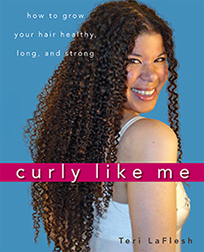
Available now!
Curly Like Me, the off-the-grid, do-it yourself owner's manual for tightly curly hair, is ready for ordering. Grab your copy today!

Every purchase made from
this site (through Amazon)
helps support it — and it
doesn't cost you anything
extra.
|
|
In the ingredient descriptions: Good means that I like to see this in a product's list of ingredients. Okay means this product appears safe for a curly person like me to use. Caution means that this ingredient may not be good in some hair care products, or for some people. Avoid means this ingredient may hurt your hair. If you see this ingredient in a hair product, it's best to put it down and walk away.
|
|
| |
Surfactant
(aka Surface active agent)
Okay
An important component in nearly all shampoos and cleansers. Used to help wet the surface better. They are also used to help remove dirt and oils from the surface to be cleaned. Keeps dirt and oil suspended in water so they can be rinsed away. The surfactant is able to get oil and oily dirt to rinse away with water because each molecule of the surfactant has a water-loving (hydrophillic) head, and a water-hating (hydrophobic) tail. Oils are attracted to the tail, and water is attracted to the head. Therefore, the surfactant molecules are able to grab the oil with one end, and the water with the other, so that the oil can be washed down the drain with the water.
Some surfactants are used as emulsifiers. Since they have both an oil-loving end and a water-loving end, they are able to hold oil and water together in a product, so the oil and water components don't separate.
There are four major types of surfactants: Cationic, Anionic, Nonionic, and Amphoteric:
Cationic surfactants: These have a positive charge. Often used as an antistatic or for sanitizing. Used as friction reducers in conditioners and fabric softeners.
Anionic surfactants: These have a negative charge. They are strong cleansers—often used as stain removers in household detergents.
Nonionic surfactants: These don't have an electrical charge. They aren't effected by hard water, and dissolve oil and grease well, so are often used as oven cleansers to remove baked on grease.
Amphoteric surfactants: Can be negatively or positively charged depending on the situation. These are frequently used in cosmetics and shampoos because they are very mild [Winter pgs 502-503].
For more information, see Surfactants and How surfactants work.
See also:
Ion Cation Anion Amphoteric Nonionic
Source(s):
Winter http://www.scienceinthebox.com/en_UK/glossary/surfactants_en.html
|
|
References:
Applewhite, Thomas H., ed. Proceedings of the World Conference on Lauric Oils: Sources, Processing, and Applications
AOCS Publishing, 1994.
Barel, André O., Marc Paye, and Howard I. Maibach., eds. Handbook of Cosmetic Science and Technology, Second Edition
Marcel Dekker, Inc., 2001.
Begoun, Paula. Don’t Go Shopping for Hair-Care Products Without Me. 3rd Edition.
Renton: Beginning Press, 2005.
Begoun, Paula. The Beauty Bible.
Renton: Beginning Press, 2002.
Begoun, Paula. Don’t Go to the Cosmetics Counter Without Me.
Renton: Beginning Press, 2003.
Bellum, Sarah, ed. The Beauty Brains: Real Scientists Answer Your Beauty Questions
New York: Brains Publishing, 2008.
Gottschalk, Tari E. and McEwen, Gerald N, Jr. PhD, eds. International Cosmetic Ingredient Dictionary and Handbook, Tenth Edition 2004, Volumes 1-4.
Washington D. C.: The Cosmetic, Toiletry, and Fragance Association, 2004.
Halal, John Hair Structure and Chemistry Simplified, Fifth Edition
Albany: Milady, 2002.
Hunting, Anthony L.L. Encyclopedia of Conditioning Rinse Ingredients.
Cranford, NJ: Micelle Press, Inc., 1987.
Hunting, Anthony L.L. Encyclopedia of Shampoo Ingredients.
Cranford, NJ: Micelle Press, Inc., 1983.
Johnson, Dale H. (Ed.). Hair and Hair Care, Cosmetic Science and Technology Series. Vol. 17.
New York: Marcel Dekker, 1997. Print.
Nnanna, Ifendu A. and Jiding Xia., eds. Protein-Based Surfactants: Synthesis: Physicochemical Properties, and Applications (Surfactant Science)
Madison Heights: CRC, 2001.
Quadflieg, Jutta Maria. Fundamental properties of Afro-American hair as related to their straightening/relaxing behaviour.
Diss. U of Rheinisch-Westfälischen Technischen Hochschule Aachen, 2003.
Schueller, Randy and Perry Romanowski, eds. Conditioning Agents for Hair and Skin.
New York: Marcel Dekker, Inc., 1999.
Winter, Ruth M.S. A Consumer's Dictionary of Cosmetic Ingredients: Complete Information About the Harmful and Desirable Ingredients Found in Cosmetics and Cosmeceuticals
New York: Three Rivers Press, 2005.
Zviak, Charles., ed. The Science of Hair Care (Dermatology)
New York: Marcel Dekker, Inc., 1986.
|
|